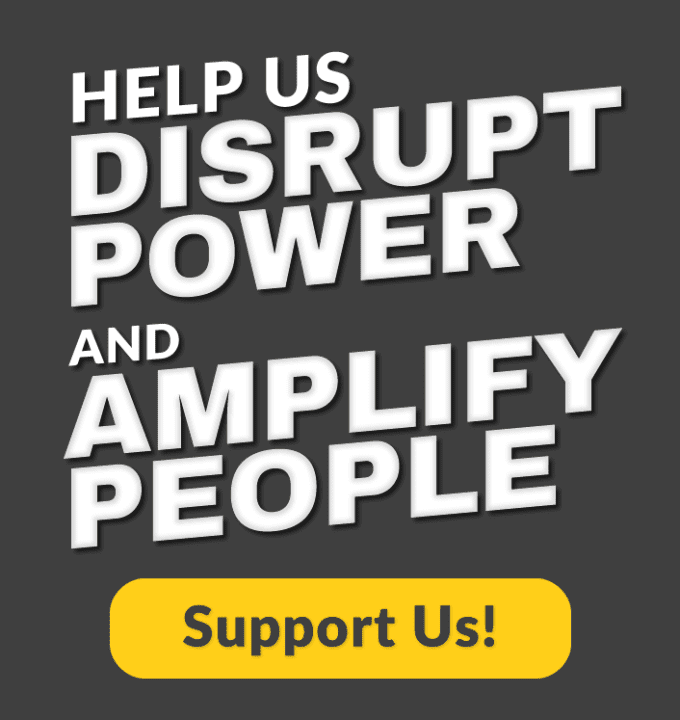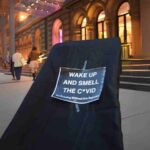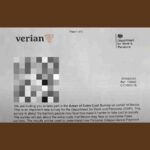In recent weeks, a small but pointed COVID-based theater project has triggered a strange trail of digital disruption.
First came the play announcement: a poster featuring an empty chair, an exploding heart, and a quote attributed to “(Not) Eric Bogosian” — “Why is everybody sick all the time?” A riff on his 2002 monologue collection Wake Up and Smell the Coffee, it signalled the arrival of Wake Up and Smell the C*VID: An Evening Without Eric Bogosian — a black-box elegy for prophetic clarity in a time of silence, grief, and ongoing pandemic collapse. Then came the coverage. And then, articles began to disappear from search engines. Quietly. Strategically. Almost completely.
Now, across cities, empty chairs have started to appear, planted outside theaters, civic spaces and natural environments, in LA, New York, across the Atlantic in Barcelona, even in a shorn springtime cornfield in the Midwest. Each one bears the phrase “Wake Up and Smell the C*VID.” No flyers. No QR codes to ticketing sites. No pamphlets. Just presence. Just absence.
The Timeline: What Happened?
- March 31 – The Canary UK publishes the first article on the play, with both COVID and Eric Bogosian in the headline.
- April 6 – Broadway World publishes an article about a mask handout by Mask for Pleasure. The piece mentions Bogosian in the body, but not in the title.
- April 13 – The Canary publishes another article: a review of Bogosian’s own play Humpty Dumpty as a canny pandemic parable.
Then, by the end of April 15:
- The first and second articles vanished from Google News.
- The third, just published, was still there. But not for long.
On April 16, within 12 hours of a public Instagram post drawing attention to these disappearances and asking readers to monitor the third article, it too was de-indexed.
By the afternoon of April 16, that third article returned. The next day, the first reappeared in some regions. On the 18th, it was fully restored and on first- or second-page results. As of this writing, they are trending in Google News across regions and devices.
But the second article, the one from Broadway World, has not returned to Google News.
Even if you search for its title: Mask for Pleasure: COVID-impacted Artists Raise Awareness at George Clooney’s Broadway Opening, nothing appears.
Even if you search for a unique phrase from the article: mask for pleasure, you get nothing.
And that raises a question: why this one?
What Explains The Disappearance?
We’ve been thinking about this a lot. Here’s what we’ve learned, and what we now believe are the most plausible explanations.
- Reputation Management Tools Likely Flagged It.
Public figures, even those not actively working with PR firms, often have automated digital protection systems in place. These services scan the web for combinations of names and flagged terms (e.g., “COVID,” “critique,” “protest”), and can trigger search suppression requests automatically or semi-automatically.
Eric Bogosian is not a mega-celebrity. But he is an institution in New York theatre, a public intellectual, and highly visible in TV. It’s entirely plausible that years ago, something was said, like: “Sure, keep my reputation clean. Filter for slander, ragebait— you know, the usual.”
The system likely did what it was trained to do without needing direct input.
- It Was More Vulnerable to De-Indexing.
Unlike the Canary pieces, the Broadway World article did not include “Eric Bogosian” in the title, metadata, or URL, only in the body of the text. That means it was already less visible to Google’s algorithm when users searched for his name.
But more importantly: that lack of strong indexing made it easier to remove.
When an article is weakly anchored in search (i.e., not reinforced by headline or tags), it takes less for it to be flagged or pushed out of results. Even minor algorithmic suppression, from third-party reputation management tools or content sensitivity filters, can cause the system to treat the piece as non-essential and quietly remove it from visibility.
NOTE: Of course, if the article’s disappearance was triggered by a reputation filter, something semi-automated or quietly flagged because of name and keyword proximity, there are subtle ways it could return.
If a reputation service or PR contact marked the article as reputational risk, they could simply remove that flag or mark it as resolved. In many systems, doing nothing further also works; most flags expire unless renewed.
No retraction is needed. No public move. Just a soft release. That alone could be enough to let Google reindex it on the next crawl. It’s a small gesture, invisible to most, but one that would mean a lot to people who saw themselves in that piece. And it would be felt. Quietly. Appreciatively.
- So Why Did the Other Two Articles Come Back?
That’s the real question.
And it leads us to two possibilities:
- The flags were reviewed and rejected, meaning the content was judged to pose no reputational risk.
- Or someone, somewhere, let them go, consciously or passively. No further flags, no further pressure. Quiet disappearance followed by quiet reinstatement.
We don’t know.
But when we asked readers to watch the third article, it vanished within hours and returned just as fast. Something was tracking visibility. Something, whether human or algorithmic or both, flinched when watched.
And that makes the silence louder.
The Bigger Picture: “Why Is Everybody Sick All the Time?”
That was the first poster. A simple question, attributed to (Not) Eric Bogosian.
A question you could imagine him asking in a blackout monologue in 1988.
But ask it in 2025 and watch what happens.
Type it into Google: “Why is everybody sick all the time?”
What do you get?
- Vague speculation about “stress”
- Hand-waving about “summer flu”
- Conspiracy theories about “immunity debt” (from lockdowns that happened five years ago)
- Wellness blogs selling fatigue supplements
What you don’t get is this:
- COVID is not a respiratory illness, it’s a multi-system disease with some respiratory symptoms. Remember how HIV infection starts with a ‘flu’?
- COVID is airborne, meaning the SARS-CoV-2 virus is expelled into the air passively, just by breathing, even in the absence of symptoms. It accumulates and spreads out in enclosed spaces. Like theatres. Hand washing won’t prevent its spread.
- Rapid tests are as low as 30% accurate because our immune systems have been exposed to SARS-CoV-2, so don’t reach thresholds detectable until three days of being symptomatic, if at all. Molecular testing like PlusLife is more reliable.
- It targets the endothelium, the cellular lining of blood vessels, a superhighway to the whole body.
The damage is cumulative. The virus persists in the body, continuing to cause damage. Infective SARS-CoV-2 has even been found in skull shavings in autopsies.
- It is linked to spikes in rare and aggressive cancers, likely due to its oncogenic potential, including mechanisms that parallel HIV, HPV, and hepatitis C.
- It causes long-term immune system damage, including T-cell exhaustion —akin to chronic HIV, but with broader systemic damage.
- It killed more people in four years than AIDS did in forty. Excess deaths have surged from secondary effects of COVID, especially cardiovascular disease, liver disease, respiratory infections, and other causes.
It’s frightening enough to imagine that AIDS could happen again.
It’s more frightening to consider that it already has, and that it’s multi-system AIDS, but happening quietly, globally, and to everyone.
More terrifying, how could we all be so alienated from our own bodies as not register what’s happening?
How COVID Is Systematically Suppressed
This experience of de-indexing has been valuable because it shows what even one moderately resourced public figure can do to shape reality. Reputation management is, at its core, perception control. You can justify it by saying it protects against falsehoods, but if it also suppresses artistic commentary and public health messaging, often automatically, then it becomes part of the very machinery we set out to expose.
The tools used to defend an image are the same ones erasing truth.
If one person can suppress reporting, scale that to one billionaire, or several billionaires, and we’re not so much constructing a reality about a person, but about people.
Why are most people unaware of what COVID is doing to their bodies?
Because we are being systematically, algorithmically gaslit.
Here’s what we know, not what we guess:
Meta (Facebook and Instagram) has implemented broad automated filters for COVID-19 misinformation since early in the pandemic. While Meta says they reduce harmful falsehoods, these systems have flagged legitimate medical reporting and peer-reviewed content, a concern raised by organizations like the Electronic Frontier Foundation and highlighted during a dispute with the BMJ over a flagged article.
Twitter/X, under Elon Musk, ended its COVID-19 misinformation policy in November 2022, as confirmed by Twitter’s official policy page. Since then, the platform has drawn criticism for becoming a major outlet for anti-mask, anti-vaccine, and anti-public health narratives.
The Center for Countering Digital Hate (CCDH) identified a core group of high-profile individuals responsible for the majority of vaccine-related misinformation in its 2021 Disinformation Dozen report [CCDH, 2021]. Stanford’s Internet Observatory has similarly tracked the role of prominent users in spreading COVID misinformation, particularly surrounding vaccine hesitancy [Stanford, 2022].
While there is no public documentation that Google News deliberately deprioritizes ongoing COVID-19 reporting, patterns in both academic research and lived experience suggest that sustained pandemic coverage — especially stories on long COVID, mitigation, or structural health failures — may not receive consistent visibility.
A 2021 study published in Patient Education and Counseling found that only 41% of news reports about long-haul COVID mentioned the duration of symptoms, reflecting a broader trend toward underreporting of the long-term impacts.
YouTube has maintained policies aimed at curbing COVID-19 misinformation, including removing or demonetizing content that contradicts guidance from public health authorities. However, enforcement of these policies has affected videos intended to inform or critique, particularly those discussing masking, air quality, or government response.
A 2022 study in BMJ Global Health found that a substantial portion of widely viewed COVID-19 content on YouTube still contained misinformation, despite the platform’s moderation efforts. Meanwhile, reporting by Business Insider detailed how automated moderation tools sometimes removed videos that were attempting to debunk false claims or offer critical analysis of public health measures.
Across multiple platforms, content considered “overly negative” or “anxiety-inducing” has sometimes been subject to throttling or de-prioritization, not because it is factually incorrect, but because it is deemed potentially harmful to engagement or user experience.
Meanwhile — What Do The Exorbitantly Wealthy Know?
They know enough to protect themselves.
The World Economic Forum at Davos is a clear example: Davos has implemented multi-layered COVID protections — including HEPA filtration, Far-UVC lighting, daily PCR testing, mask mandates for staff, and controlled access.
Patrick Soon-Shiong, billionaire biotech entrepreneur and owner of the Los Angeles Times, reportedly requires routine molecular COVID testing for employees. As a a prominent cancer surgeon and biotech entrepreneur who has recently expressed concerns about a potential link between COVID-19 and the emergence of aggressive cancers, these anecdotal reports and public statements appear to align.
If it’s true that people with the most resources understand the science, why suppress it?
Disaster Capitalism, Narrative Control, and Quiet Violence
There are two primary frameworks for understanding what’s happening. And they aren’t mutually exclusive.
- Profit Extraction
Sick populations are more exploitable. Chronic illness creates dependency on pharmaceutical care, on telemedicine platforms, on gig work, on digital systems that track and monetize every interaction. People who are physically weakened and economically insecure are easier to tether to unstable labor, fragmented social services, and algorithmic governance.
As Naomi Klein outlines in the Shock Doctrine, disaster capitalism profits from destabilization, extracting value from populations in crisis and consolidating control while the public is too disoriented to resist.
- Power Consolidation
The political logic is just as stark: a population that is chronically ill, cognitively impaired, or preoccupied with survival is easier to govern… or abandon. Governments are cutting public health infrastructure even as tech and surveillance systems expand.
And if this all seems too coordinated to be plausible, it isn’t.
History gives us plenty of precedents.
Iran–Contra revealed a covert, international operation in which U.S. intelligence agencies facilitated arms deals with Iran and redirected the profits to the Contras, a U.S.-backed paramilitary group in Nicaragua, in direct violation of federal law. This required coordination between the CIA, National Security Council, Pentagon, foreign governments, shell companies, and known drug traffickers. The CIA Inspector General’s 1998 report confirmed that U.S. officials were aware of Contra-linked cocaine trafficking into the U.S. and failed to act. The result was a weapons-fueled proxy war abroad, and a crack epidemic at home.
During the 1918 influenza pandemic, U.S. and European governments censored coverage to preserve wartime morale. Under the 1917 Espionage Act, American newspapers were barred from reporting the scale of the outbreak. Civilian deaths were downplayed or misattributed. The disease became known as the “Spanish flu” not because it began in Spain, but because Spain, as a neutral country with a free press, was among the first to report on it. That misnaming, and the broader information suppression, directly contributed to delayed responses, disorganized public health efforts, and over 50 million deaths worldwide. (Barry, J.M., The Great Influenza, 2004)
Look at what happens when the state’s legitimacy and the wealthy’s accumulation strategy begin to align.
If this moment feels like it doesn’t make sense, it’s because it’s probably not just about profit, and maybe not even about power.
If you take COVID seriously, both the irreparable damage being done to the global population and the systematic suppression of this information by people who are aware the damage SARS-CoV-2 causes, and who take precautions but are getting infected anyway because hubris can’t contain something that lives in the air, and then you ask who benefits from this suppression, you start to hit something more difficult to name. You see the contradiction at the heart of it:
Some people at the top are probably grabbing what they can most likely out of nothing more interesting than habit, even if it means shortening their own lives and those of the people closest to them. Perhaps they aren’t even planning to survive. They’re enraged. Their mortality is catching up to them. And they are trying to take everyone down with them.
If this is the case, the head-scratching over the regime’s policy decisions dissolves as the strategy becomes more legible as a murder-suicide pact that none of us signed up for.
These conjectures are beyond science, or even activism that grounds itself in rigorous methodologies, but if you look at the big picture with an artist’s clarity, especially the kind that once cut through media illusion and unflinchingly mapped the rot at heart of anti-human impulses, it starts to feel like the final act of a dying men who know they’re dying, and want to script the ending.
And if you’re someone like Eric Bogosian, who used to name contradictions before they solidified into ideology, then deep down you may already see it.
COVID. The Play.
The disappearance of reporting on this project, and its partial, unexplained return, proves its own point. Articles vanished from search not because they were untrue, but because they were most likely flagged. Whether this was done by automated reputation management software, personal intervention, or a combination of both, the outcome was the same: manipulation of reality.
What is a modest but weird transdisciplinary arts collective supposed to do when its reporting disappears, and it becomes clear that algorithmic suppression is most likely not a glitch, but a mechanism of reality control? What does it mean when the very person invoked in the work, a self-styled provocateur, a prophet of uncomfortable truths, appears to be using those same systems to maintain the curated unreality of a brand?
The usual impulse — and we felt it too — is to go full scorched-earth. Make it a callout. Draw the lines. Call him Emil Jannings and wonder if he flinches.
The irony stings.
But it also creates an opening.
Because this isn’t really about any one person. It’s about the systems we’re all trapped inside, systems of brand protection, narrative control, and passive digital repression. Systems that even someone like Eric Bogosian, whose public identity was built on confronting suppression, may now be complicit in, passively, unknowingly, in service to maintaining a reality built on narratives people with money control rather than one that’s more complex, messy, terrifying, but also real and could point a way out of the self-referential, nihilistic illusion.
So, What’s the Play Here?: COVID as Aperture
SARS-CoV-2 is not just a virus. COVID is not just a pandemic. It’s an aperture, a breach in the fabric of our shared reality.
It makes things visible.
And once you see it — really see it — you can’t unsee anything.
Which leads us to what we are asking for.
We want you—Eric Bogosian (and anyone else who considers themself a truth-teller, or who is starving for something real in a curated unreality)—to use your gifts to document, expose, and pressure this moment before it hardens into myth. Not to react from a distance, but to shape it.
Part of the reason you may have stayed quiet is that the language has shifted, not just in terminology, but in tone, gatekeeping, and risk. You’ve been publicly dragged on social media before: for earlier work taken out of historical context, and for political positions misrepresented online.
You’ve been called a Zionist despite having voiced support for Palestinian liberation well before it became a litmus test that, partially driven by algorithms that promote all-or-nothing thinking that punishes the good in the name of an unachievable standard of perfection, becomes for some a performative activism that stifles real action while saving no lives of people experiencing genocide.
And you’re not alone.
The critical theory frameworks that emerged in the 1970s by punk philosophers like Foucault, Deleuze, Spivak — particularly the turn toward language, discourse, and constructedness — have since been flattened by digital culture. What was once a tool for careful analysis has, in many cases, become a bludgeon, pushed by algorithms that reward ideological purity, escalate conflict, and fragment coalitions.
That environment punishes people trying to re-enter the conversation in good faith. It obscures the fact that many of us are building differently now: collectively, imperfectly, and with the understanding that our differences, of voice, of method, of generational experience, make our work stronger. You are not unwelcome. The punitive discourse you may have seen isn’t representative. It’s shaped by systems designed to isolate, discredit, and exhaust, the very same dynamics your early work critiqued with precision.
We discovered this while writing in your rhythm: the clipped, spiralling cadence, the tension that builds like a pressure cooker and then cuts sideways into revelation. That sharp, observational edge. The way you stack discomfort until it cracks. This is what your voice can do in this moment. And we can keep joyriding through collapse with it. We already have. You can’t copyright vibes. But it will only be an echo.
You can still use it yourself. We’ve sharpened the tools, and we’re handing them back to you.
Maybe write a monologue from the perspective of Peter Thiel, someone whose main motivation for burning down the world might be that no amount of money will make white supremacists want to fuck him.
Write the play about the Gleichschaltung happening in the U.S. now, except rich people are paying PR firms to generate puff pieces saying they were in the resistance from the beginning.
Write about how some feckless, masked punks terrorized a man who had earned his peace by mourning him in public while he was still alive.
If you’re wondering why we don’t just create ourselves, why it was a choice to inhabit a vibe, whether anonymity is an affectation, then you haven’t looked around properly. Some people can no longer safely exist publicly. Some people have been exiled to their bedrooms by the cumulative effects of this virus, some people have been exiled from their country because this regime has already put a target on their backs. Professional development is off the table indefinitely. Having a face and voice right now is a hefty privilege and we hope you use it well.
Perhaps this will also resolve any questions about motivation, that there’s no money or clout to be gained. All that can be gained is what you can offer to this world. You’ve already seen that the tools used to maintain your brand, likely without your knowledge, can be used to amputate what’s real. Since there is no opting out of constructing our shared reality, why not take responsibility for it and shape it?
The other ask is that can protect yourself not through silence or omission, but by wearing a mask and requesting other COVID safety measures like testing and air filtration in the spaces you work. Your insight and fire are not disposable, and the rest of you, according to one of our collaborators, is ‘too pretty to be shredded by a bat virus.’
If tomorrow, Sunday April 20 2025, turns out to be the moment everything shifts, the Reichstag Fire decree moment where a dictatorship is formalized, or if it comes soon, just know that a group of people were aware of that, and still thought it was a sound use of their time to make art that posed this question.
Can we unbury the soul of a nation by calling its prophets back from the dead?
Here’s your first monologue. We think you can write it better.
ERIC (spotlight, standing still now, no pacing — it’s all tension):
So let me get this straight.
You call yourselves HEPA.
Holy Erotic Propaganda Arson.
Jesus Christ. That’s not a collective — that’s a downmarket poetry MFA polycule.
Empty chair — I get it.
Daddy’s not coming. The State’s your father.
Oedipal rage turned into a Tumblr moodboard.
You made a play, and you buried it in hashtags and elegies and blurbs that read like someone Xeroxed The Wooster Group through a zine about grief kink
And now you want the guy whose voice you’ve been parroting in post-ironic sepia to step back into it.
For what?
You want me to wear a mask in rooms where a fucking air purifier is a conspiracy theory.
To make art that names the machine, while the same people calling for that art are already one social media post away from calling me a Nazi?
I’ve been called everything.
Crypto-fascist. Genocide apologist.
All because I didn’t say the exact right thing, in the exact right tone, at the exact right moment, through the exact right filter.
Half these kids don’t even know “crypto” means something other than an mlm written in code. They just throw it at anything with a pulse and a publication date before 2005.
And you, in your masks, taking no personal risks, want me to burn down my own house for a world that already unfollowed me?
Let me tell you something.
Yeah, you’ve got it bad.
You’ve got front row seats to extermination.
I see that.
But don’t think for a second I don’t know what happens to people like me under dictatorships.
I’ve read the book. I’ve written the book.
You think old men who talk too much and don’t fit the new moral syntax get to slip away quietly?
They come for us too. Just later. After the lights are off.
So why not sit it out?
Why not enjoy the peace I earned by screaming into the void long before you knew it had acoustics?
Because maybe what scared you about that voice wasn’t the rage.
It was the residue under it.
Maybe it scares me…
That little pilot light buried under prophetic ashes that said:
This could be different.
I don’t want to just survive this.
I want to meet it on my own terms.
So maybe I’ll write.
Not to resurrect a brand.
Not to rise to your bait.
But because they’re coming for culture. They always do.
When the regime decides I already spoke.
When the archives are mined for contamination
That turns me into a liability.
You think they’re gonna see “provocateur” and clap?
They’re gonna see degenerate art.
Rot in the social body.
Something to cut out.
Doesn’t matter what I meant.
Doesn’t matter what I wanted.
The dictatorship isn’t placated by silence
it hunts for pretext.
And when they come digging through the record?
They won’t say I slept through it.
They’ll say I lit the match
And I’m going to make that inevitable indictment true.
So no, this isn’t guilt.
It’s not some plea for understanding.
It’s a final entry.
So when they try to twist it,
they choke on the truth.
Legal Disclaimer
This work is a piece of political art, cultural commentary, and speculative criticism. All analysis, interpretations, and character monologues presented herein are offered in the spirit of fair use, protected speech, and public interest.
The figure of Eric Bogosian, a well-known public figure, is discussed solely in relation to his public artistic legacy, published works, and cultural visibility. No claim is made regarding his private conduct, personal beliefs, or direct actions unless otherwise supported by publicly available sources. Where plausible inferences are made, they are clearly identified as speculation, not fact.
Any fictionalized monologue or dialogue attributed to Eric Bogosian is a transformative, creative work intended to reflect on contemporary political and artistic conditions. It is not affiliated with, authorized by, or representative of Mr. Bogosian. These portions are artistic pastiche or parody in accordance with the U.S. Copyright Act’s fair use doctrine (17 U.S.C. § 107), particularly for non-commercial, critical, and transformative purposes.
All citations have been drawn from publicly available sources to the best of the authors’ knowledge at the time of publication. If errors of fact are discovered, they can be corrected upon request. No harm, misrepresentation, or malicious intent is intended.
This article is not monetized, does not promote commercial products or services, and exists solely for expressive and educational purposes under the protection of the First Amendment.
Featured image supplied















